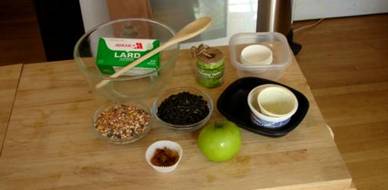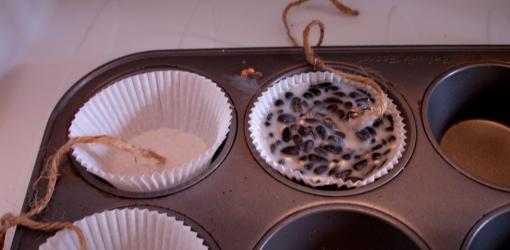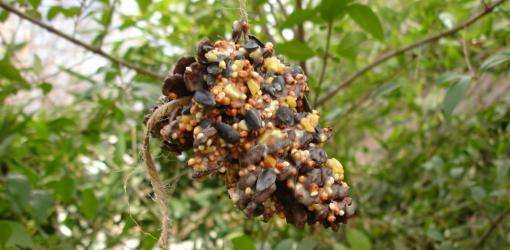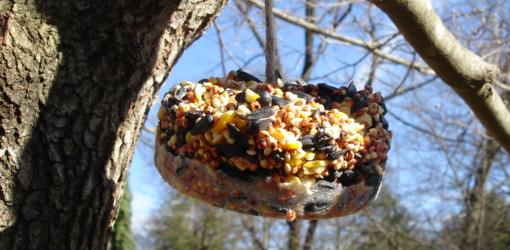
|
Food Waste Is For The Birds:
How to Make a Suet Bird Feeder
by Alice Osborne
Courtesy: DannyLipford.com
In today’s article “ 50 Ways to Never Waste Food Again,” tip #33 suggests using the fat you trim from your meat cuts to make suet bird feeders. This sounded cool, so we did our research. Here’s what we found from Home Improvement Guru, Danny Lipford:
 Suet bird feeders are a great source of nutrition for birds during the winter.
Suet bird feeders are a great source of nutrition for birds during the winter.
When the weather is cold, many birds rely on fat to help them survive freezing temperatures. A bird feeder made of suet or other fat is a great way to help out the birds during the winter, and it’s an easy and fun project to tackle on a cold winter’s day. With supervision, this can be a great project for kids, too.
 Make your own blocks of suet using plastic sandwich containers as molds.
Make your own blocks of suet using plastic sandwich containers as molds.
What is a Suet Feeder?
Suet is usually composed of the rendered fat from kidneys or loins of beef. It can be purchased from butcher shops or meat markets in block form, or you can make it yourself by heating and straining fat trimmings. Suet is a good choice for bird feeders since it can withstand warm temperatures without melting, but you can use other types of fat to feed your feathered friends as well.
Store bought suet feeders consist of a wire mesh cage or plastic mesh bag with a cake of hardened suet placed inside. The suet is often mixed with birdseed or berries to attract a variety of birds. You can make replacement cakes for premade feeders, or you can make your own feeder to hang outdoors or place on the ground.
Suet feeders attract many types of birds, including finches, bluebirds, wrens, sparrows, robins, woodpeckers, cardinals, chickadees, and nuthatches. Experiment with different types of fat and fillings to see what birds are attracted to your feeder.
 Making suet feeders can be completed in about 15 minutes.
Making suet feeders can be completed in about 15 minutes.
How To Make a Fat-Cake Feeder
To make a suet feeder, you will need:
A microwave-safe mixing bowl, or saucepan if done on the stove
Mixing spoon or ladle
Rendered beef suet or other fat that is solid at room temperature
Birdseed or other goodies to mix with the suet – about two measures of filling for each measure of fat
Containers, molds, plastic wrap, or foil
Twine for making hanging feeders
Follow these steps:
1. Poke a hole in the bottom of your container and thread a piece of knotted twine through the hole to serve as a hanger.

2. Gently melt the fat in a saucepan over low heat, or in the microwave for 30 seconds at a time.
3. Remove from heat, and stir your filling into the melted fat until well mixed.

4. Spoon the mixture into the containers, making sure the string sticks out the top.
5. Refrigerate for at least an hour until hardened. If you are making a large quantity, freeze extras for later use.

6. When the cake has solidified, you can cut away the container or remove the lining (if desired), and hang your feeder outdoors in a shady, cool spot.

Suet “ornaments” make great bird-attracting decorations for evergreens.
Fat Sources
Any fat that is solid or semi-solid at room temperature will work. Harder fats will hold their shape better in cake-type feeders; softer fats will work better in container or log feeders.
Ideas for fat include:
Rendered suet, tallow, or animal fat
Lard or shortening
Recycled bacon or pork/beef roast drippings
Pure, unsalted peanut butter
Coconut oil
Unsalted butter
Save meat fat trimmings in the freezer, then learn to render your own suet. For detailed instructions, check out this great article at Dave’s Garden by Cathy Wallace on Rendering Fat for Suet.
Fillings
Fillings can be made from:

Bird seed
Chopped up apples or other fruit
Berries such as cranberries or blueberries
Unsalted, raw chopped peanuts
Whole-wheat flour, oatmeal, cornmeal, or wheat berries
Pieces of bread, or cooked, unsalted rice
Seeds such as black sunflower, hemp, millet, or linseed
Containers
Get creative! You can make suet feeders out of most anything you can find around the house.
Ideas for cake-type feeders include:

Raid your recycle bin for old yogurt cups, frozen food trays, or other plastic containers.
Muffin tins lined with paper baking cups.
Shaped molds or plastic eggs.
Grapefruit or melon rinds, eggshells, coconut hulls, ice-cream cones, or taco shells.
Container tips:
To make a replacement suet cake for your metal feeder, use a disposable, square, plastic sandwich container.
If you plan to reuse the container, line it with foil or plastic wrap for easy removal.

Pinecone feeders are great projects for kids!
Rolled or Log Feeder
To make a log or pinecone feeder, you will need:
Pinecones, sticks, or small logs with holes drilled in them
Twine
Softened fat such as unsalted peanut butter, shortening, or lard
Birdseed or other filler
Follow these steps:
1. Tie a piece of string or twine to the top of the pine cone for hanging.
2. Smear the pine cone, stick, or log with fat.
3. Roll the “log” in bird seed or a mixture of seed and fruit.
4. Hang outside and enjoy!

Suet Feeder Tips
For a sucessful suet feeder:
Keep in a cool, shady spot since fatty feeders can go rancid in warmer temperatures.
Wash and disinfect your feeder or container each time you replace the suet.
Be careful when heating fat! All fats are flammable at high temperatures, and superheated fats will melt your plastic containers!
Gentle melting is all that is needed to make suet feeders, so use low heat or short bursts in the microwave.
Contribute to the Cook'n Club!
DVO would love to publish your article, prose, photography and art as well as your cooking, kitchen and nutrition tips, tricks and secrets. Visit the Newsletter Submission / Win Win for All section in our Forum for more information and details.
|
|


